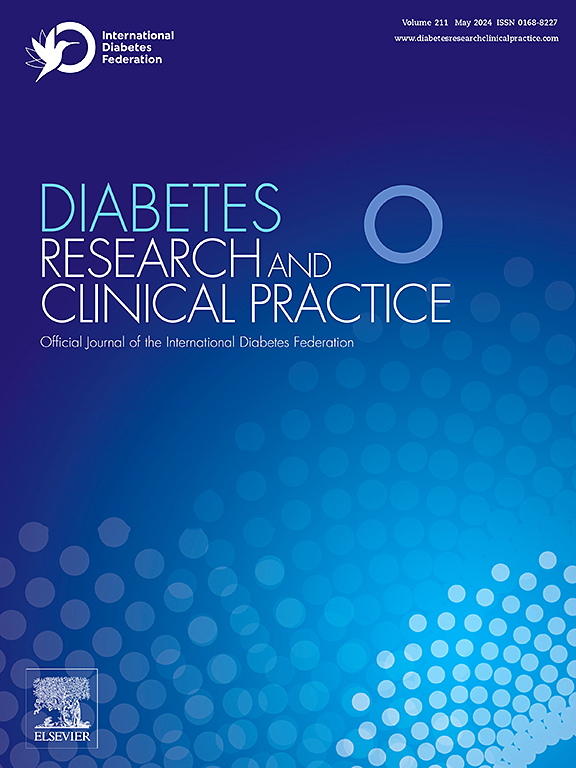2型糖尿病患者额顶皮层-壳核-小脑网络的神经血管解耦:异常饮食模式的潜在生物标志物
IF 6.1
3区 医学
Q1 ENDOCRINOLOGY & METABOLISM
引用次数: 0
摘要
限制性饮食引发的高辍学率和暴饮暴食限制了饮食干预在2型糖尿病(T2DM)中的有效性。然而,目前尚不清楚t2dm特异性饮食行为特征的潜在核心基础是什么。方法选取41例T2DM患者和43例健康对照(HC)进行静息状态功能MRI检查,通过有效连通性(EC)分析筛选可疑网络,并探讨其动态时间和神经血管耦合特性。此外,评估T2DM进展过程中神经病理改变的时间线。结果T2DM患者不受控制的进食、内外饥饿位点增加。2型糖尿病患者额顶皮质-壳核-小脑网络EC明显增高(P = 0.023)。T2DM患者最致密状态的分数窗(P = 0.009)和平均停留时间(P = 0.009)显著高于T2DM患者。额顶叶皮层-壳核-小脑网络的神经血管解耦与这些t2dm特异性饮食行为特征相关。右侧壳核神经血管解耦系数(Putamen_R)在T2DM发病初期发生改变。结论额顶皮层-壳核-小脑网络是t2dm相关的可疑进食模式网络。神经血管网络的解耦,特别是Putamen_R的解耦,发生得较早,可能是T2DM患者异常饮食模式的生物标志物。本文章由计算机程序翻译,如有差异,请以英文原文为准。
Neurovascular decoupling of frontoparietal cortex-putamen-cerebellum network in type 2 diabetes patient: Potential biomarker for abnormal eating patterns
Aim
High rates of dropout and binge eating triggered by restrictive diet limit the effectiveness of dietary interventions in type 2 diabetes mellitus (T2DM). However, it remains unclear what the potential central underpinnings of T2DM-specific dietary behavior characteristics are.
Methods
41 T2DM patients and 43 matched healthy controls (HC) who underwent resting state functional MRI were enrolled to screen for the suspicious network by effective connectivity (EC) analysis and to explore its dynamic temporal and neurovascular coupling properties. Additionally, the timeline of neuropathological changes during T2DM progression was evaluated.
Results
Increased uncontrolled eating, internal and external loci of hunger were found in T2DM. EC of the frontoparietal cortex–putamen–cerebellum network was significantly higher in T2DM patients (P = 0.023). The fractional windows (P = 0.009) and mean dwell time (P = 0.009) of the densest state were significantly higher in T2DM patients. Neurovascular decoupling of the frontoparietal cortex-putamen-cerebellum network was correlated with these T2DM-specific eating behavior characteristics. Neurovascular decoupling coefficient of right putamen (Putamen_R) changed at the very beginning of T2DM.
Conclusion
The frontoparietal cortex–putamen–cerebellum network was the suspicious T2DM-related abnormal eating pattern network. Neurovascular decoupling of the network, especially that of Putamen_R, occurred early and might serve as a biomarker for abnormal eating patterns in T2DM patients.
求助全文
通过发布文献求助,成功后即可免费获取论文全文。
去求助
来源期刊

Diabetes research and clinical practice
医学-内分泌学与代谢
CiteScore
10.30
自引率
3.90%
发文量
862
审稿时长
32 days
期刊介绍:
Diabetes Research and Clinical Practice is an international journal for health-care providers and clinically oriented researchers that publishes high-quality original research articles and expert reviews in diabetes and related areas. The role of the journal is to provide a venue for dissemination of knowledge and discussion of topics related to diabetes clinical research and patient care. Topics of focus include translational science, genetics, immunology, nutrition, psychosocial research, epidemiology, prevention, socio-economic research, complications, new treatments, technologies and therapy.
 求助内容:
求助内容: 应助结果提醒方式:
应助结果提醒方式:


